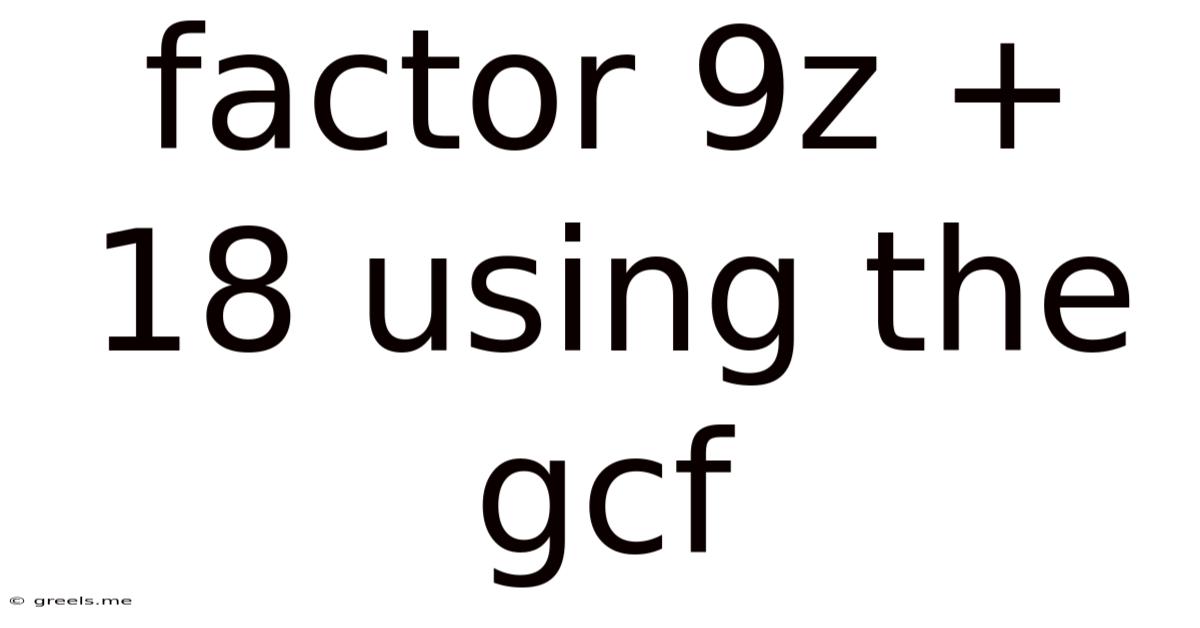Factor 9z + 18 Using The Gcf
Greels
Apr 23, 2025 · 5 min read

Table of Contents
Factoring 9z + 18 Using the GCF: A Comprehensive Guide
Factoring algebraic expressions is a fundamental skill in algebra. Understanding how to factor, particularly using the greatest common factor (GCF), is crucial for simplifying expressions, solving equations, and tackling more advanced algebraic concepts. This article will delve deep into factoring the expression 9z + 18 using the GCF, explaining the process step-by-step and exploring the underlying mathematical principles. We'll also explore the broader context of GCF factoring and its applications.
Understanding the Greatest Common Factor (GCF)
Before we tackle factoring 9z + 18, let's solidify our understanding of the GCF. The greatest common factor of two or more numbers is the largest number that divides evenly into all of them. For example, the GCF of 12 and 18 is 6 because 6 is the largest number that divides evenly into both 12 and 18. The same principle applies to algebraic expressions. We look for the largest term that divides evenly into all terms within the expression.
Finding the GCF of Numbers
To find the GCF of numbers, we can use several methods:
-
Listing factors: List all the factors of each number and identify the largest common factor. For example, the factors of 12 are 1, 2, 3, 4, 6, and 12. The factors of 18 are 1, 2, 3, 6, 9, and 18. The largest common factor is 6.
-
Prime factorization: Break down each number into its prime factors. The GCF is the product of the common prime factors raised to the lowest power. For example:
- 12 = 2² × 3
- 18 = 2 × 3²
- The common prime factors are 2 and 3. The lowest power of 2 is 2¹ and the lowest power of 3 is 3¹. Therefore, the GCF is 2 × 3 = 6.
Finding the GCF of Algebraic Terms
Finding the GCF of algebraic terms involves considering both the numerical coefficients and the variables.
-
Numerical coefficients: Find the GCF of the numerical coefficients as described above.
-
Variables: Identify the common variables and choose the lowest power of each common variable. For example, the GCF of x²y and xy³ is xy.
Factoring 9z + 18 Using the GCF
Now, let's apply our understanding of the GCF to factor the expression 9z + 18.
Step 1: Find the GCF of the terms.
The terms in the expression are 9z and 18.
-
Numerical coefficients: The GCF of 9 and 18 is 9.
-
Variables: The variable 'z' is present in only one term (9z), so it's not a common variable.
Therefore, the GCF of 9z and 18 is 9.
Step 2: Factor out the GCF.
We factor out the GCF (9) from each term in the expression:
9z + 18 = 9(z) + 9(2)
Step 3: Rewrite the expression.
Since we've factored out the 9, we rewrite the expression as:
9z + 18 = 9(z + 2)
This is the factored form of the expression 9z + 18. We have successfully expressed the original expression as the product of its GCF and another simpler expression.
Verification: Expanding the Factored Form
To verify that our factoring is correct, we can expand the factored form using the distributive property:
9(z + 2) = 9(z) + 9(2) = 9z + 18
This matches our original expression, confirming that our factoring is accurate.
Applications of GCF Factoring
GCF factoring is a fundamental tool with numerous applications in algebra and beyond:
-
Simplifying expressions: Factoring simplifies complex expressions, making them easier to understand and manipulate.
-
Solving equations: Factoring is essential for solving quadratic equations and other polynomial equations. The factored form allows us to find the roots (or solutions) of the equation.
-
Finding common denominators: In working with fractions, factoring can help in finding the least common denominator (LCD), simplifying fraction addition and subtraction.
-
Calculus: Factoring is used extensively in calculus for differentiation and integration.
-
Real-world applications: Factoring finds applications in various fields such as physics, engineering, and economics where mathematical modeling is used. For example, it can help in optimizing designs or predicting outcomes.
Further Exploration: Factoring More Complex Expressions
While 9z + 18 is a relatively simple example, the principles of GCF factoring extend to more complex expressions. For example, consider the expression 15x²y + 25xy².
Step 1: Find the GCF:
-
Numerical coefficients: The GCF of 15 and 25 is 5.
-
Variables: The common variables are x and y. The lowest power of x is x¹ and the lowest power of y is y¹.
Therefore, the GCF is 5xy.
Step 2: Factor out the GCF:
15x²y + 25xy² = 5xy(3x) + 5xy(5y)
Step 3: Rewrite the expression:
15x²y + 25xy² = 5xy(3x + 5y)
This demonstrates how the same principles can be applied to more complex expressions with multiple variables and higher powers.
Conclusion: Mastering GCF Factoring
Mastering GCF factoring is a cornerstone of algebraic proficiency. Understanding the process, from identifying the GCF to rewriting the expression in its factored form, is crucial for success in algebra and beyond. The ability to factor expressions efficiently and accurately simplifies calculations, solves equations, and opens the door to tackling more advanced mathematical concepts. By practicing with various examples, gradually increasing in complexity, you can solidify your understanding and develop a strong foundation in this fundamental algebraic skill. Remember to always check your work by expanding the factored form to verify its equivalence to the original expression. This practice reinforces your understanding and helps prevent errors. Consistent practice is key to mastering this important skill.
Latest Posts
Related Post
Thank you for visiting our website which covers about Factor 9z + 18 Using The Gcf . We hope the information provided has been useful to you. Feel free to contact us if you have any questions or need further assistance. See you next time and don't miss to bookmark.